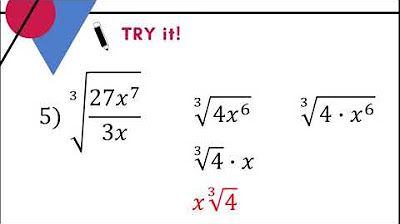How To Simplify Radicals
Summary
TLDRThis lesson focuses on simplifying radicals, starting with basic square roots and moving into more complex expressions involving imaginary numbers. It covers the identification of perfect squares, the process of breaking down non-perfect squares into their components, and techniques for combining and rationalizing radical expressions. Examples include simplifying roots of both positive and negative numbers, as well as practical exercises that illustrate how to add and subtract radicals effectively. The video emphasizes practice to master the concepts, making it a valuable resource for understanding radical simplification in mathematics.
Takeaways
- 😀 Understanding radicals involves recognizing both real and imaginary numbers.
- 😀 The square root of a positive number is a real number, while the square root of a negative number results in an imaginary number.
- 😀 Perfect squares up to 10 include 1, 4, 9, 16, 25, 36, 49, 64, 81, and 100.
- 😀 To simplify non-perfect squares, break them down into factors that include a perfect square.
- 😀 The square root of 75 can be simplified to 5√3 by factoring it as 25 × 3.
- 😀 When adding or subtracting radicals, simplify each radical individually before combining them.
- 😀 Rationalizing the denominator can be achieved by multiplying the numerator and denominator by the square root present in the denominator.
- 😀 The conjugate is used to rationalize expressions, helping eliminate square roots from the denominator.
- 😀 It’s important to practice simplifying various expressions to master the concept of radicals.
- 😀 The final results should be expressed in simplified forms, highlighting both numerical and radical components.
Q & A
What is the square root of 36, and how is it simplified?
-The square root of 36 is 6, which is a real number.
What does it mean to take the square root of a negative number?
-The square root of a negative number results in an imaginary number. For example, the square root of -49 simplifies to 7i, where i is the square root of -1.
How do you simplify the square root of 75?
-To simplify the square root of 75, you can break it down into 25 and 3 (since 25 is a perfect square). This gives you sqrt(75) = sqrt(25) * sqrt(3) = 5sqrt(3).
What perfect square goes into the number 18?
-The perfect square that goes into 18 is 9, since 18 can be expressed as 9 times 2. Therefore, sqrt(18) simplifies to 3sqrt(2).
How can you add or subtract radical expressions?
-To add or subtract radical expressions, first simplify each radical individually. Then, combine the coefficients of the like radicals. For example, 4sqrt(8) + 3sqrt(15) - 6sqrt(32) simplifies to -1sqrt(2).
What is the process for rationalizing the denominator?
-To rationalize the denominator, multiply the numerator and the denominator by the square root of the denominator. For example, for the expression 5/sqrt(2), you would multiply by sqrt(2) to get (5sqrt(2))/2.
What should you do if a radical expression includes a fraction?
-If a radical expression includes a fraction, it is often helpful to multiply the numerator and denominator by the conjugate of the denominator to simplify.
How do you simplify the expression 3 + sqrt(2) / (5 - sqrt(2))?
-To simplify this expression, multiply the numerator and denominator by the conjugate of the denominator, which is (5 + sqrt(2)). This eliminates the radical in the denominator.
What is the result of 8 divided by 3sqrt(2) after simplification?
-After rationalizing the denominator, the expression simplifies to 24 + 8sqrt(2) / 7.
Can you explain how to simplify the square root of 80?
-To simplify sqrt(80), identify the highest perfect square that divides 80, which is 16. So, sqrt(80) = sqrt(16) * sqrt(5) = 4sqrt(5). Then, multiply by any coefficients, like 8, to get 32sqrt(5).
Outlines

This section is available to paid users only. Please upgrade to access this part.
Upgrade NowMindmap

This section is available to paid users only. Please upgrade to access this part.
Upgrade NowKeywords

This section is available to paid users only. Please upgrade to access this part.
Upgrade NowHighlights

This section is available to paid users only. Please upgrade to access this part.
Upgrade NowTranscripts

This section is available to paid users only. Please upgrade to access this part.
Upgrade Now5.0 / 5 (0 votes)





